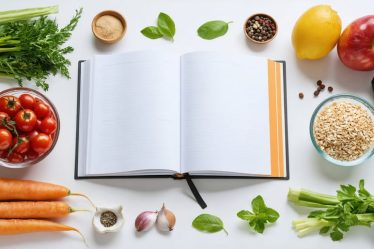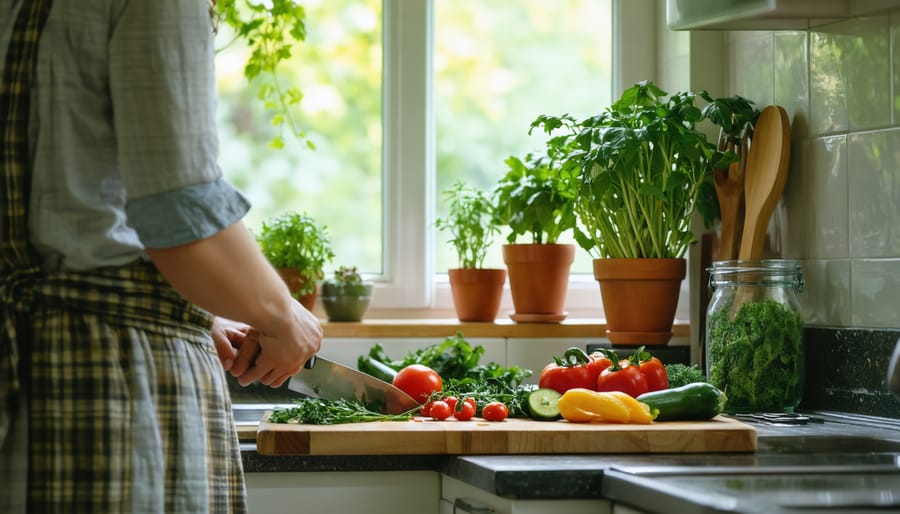
Imagine your kitchen as a sacred space where each ingredient tells a story and every knife stroke becomes a meditation. Conscious cookery transforms the daily act of meal preparation into a mindful practice that nourishes both body and soul. Far beyond simply following recipes, it’s about creating a deeper connection with our food, understanding its origins, and honoring the journey from earth to plate.
When we cook consciously, we become fully present in the moment – feeling the weight of a ripe tomato, inhaling the earthy aroma of fresh herbs, and listening to the gentle sizzle of olive oil in a warming pan. This awareness not only elevates the quality of our meals but also brings a sense of peace and purpose to our daily routines.
In today’s fast-paced world, where meals are often rushed and mindless, conscious cookery offers a path back to intention and joy in the kitchen. It’s about making choices that benefit our health, support our local communities, and protect our planet. Whether you’re a seasoned chef or just beginning your culinary journey, embracing conscious cookery can revolutionize your relationship with food and transform everyday cooking into an act of self-care and environmental stewardship.
What Makes Cooking Truly Conscious?
Mindfulness in the Kitchen
Have you ever noticed how different cooking feels when you’re fully present in the moment? Practicing mindful cooking habits can transform your kitchen from a place of rushed meal prep into a sanctuary of culinary meditation.
When we bring mindfulness to our cooking, every sensation becomes heightened. The aromatic herbs releasing their fragrance as you chop them, the satisfying sizzle of vegetables hitting a hot pan, and the rhythmic motion of kneading dough all become opportunities for presence and connection.
I’ve found that taking just a few deep breaths before starting to cook helps set the tone for a more conscious experience. Try focusing on one task at a time, whether it’s washing produce or stirring a sauce, rather than multitasking. Notice the colors, textures, and smells of your ingredients. Feel the weight of your knife, the coolness of fresh vegetables, the warmth of the stove.
This mindful approach not only makes cooking more enjoyable but often results in better-prepared meals and a deeper appreciation for the food we create. It’s about slowing down and savoring not just the end result, but every step of the journey.
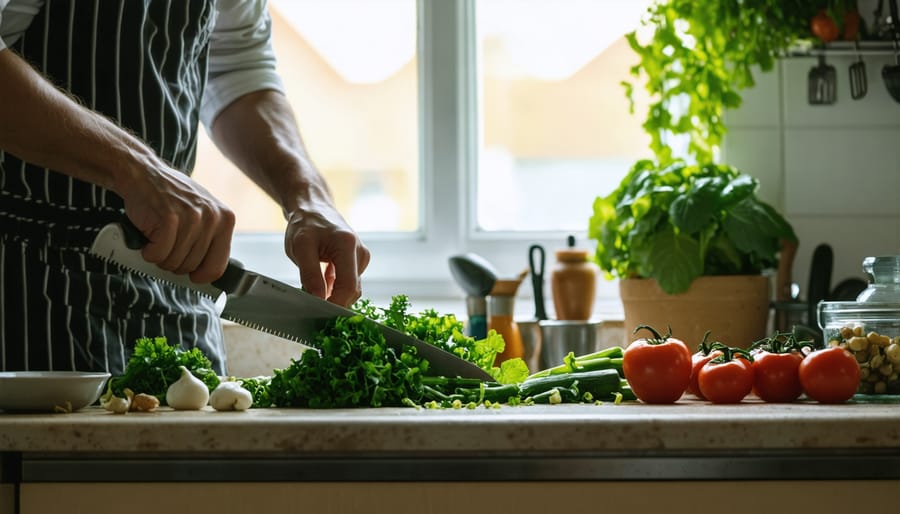
Connection with Ingredients
Have you ever paused to really consider where your ingredients come from? Developing a mindful relationship with food starts with understanding its journey to your kitchen. When I first started visiting local farmers’ markets, I was amazed by the stories each vendor shared about their produce. That connection transformed how I cook and appreciate meals.
Take a moment to examine your ingredients before cooking. Notice the vibrant colors of fresh vegetables, inhale the earthy aroma of mushrooms, or feel the firm ripeness of an avocado. This sensory exploration helps you understand the optimal way to prepare each ingredient and creates a deeper appreciation for nature’s bounty.
Consider starting a small herb garden, even if it’s just a few pots on your windowsill. Growing your own ingredients, however modest, creates an intimate understanding of food production and seasonality. It’s a beautiful reminder that our ingredients are living things that deserve respect and careful handling in our cooking process.
Essential Conscious Cooking Practices
Mindful Ingredient Selection
Every time I step into my local farmers’ market, I’m reminded that conscious cooking begins long before we turn on the stove. It starts with the thoughtful selection of each ingredient that will eventually make its way to our plates. When we choose our ingredients mindfully, we’re not just picking items off a shelf – we’re making decisions that impact our health, our community, and our planet.
Start by getting to know your ingredients’ origins. Take a moment to read labels, ask questions at your local market, and research the farms and producers in your area. I’ve found that building relationships with local vendors not only ensures better quality ingredients but also creates a meaningful connection to our food system.
Consider seasonality when selecting produce. In-season fruits and vegetables aren’t just more flavorful and nutritious; they’re typically more affordable and have a lower environmental impact. Keep a seasonal produce guide on your phone or refrigerator as a helpful reminder.
Pay attention to packaging and try to choose items with minimal or sustainable packaging when possible. Bring your own reusable bags and containers for bulk items. Remember that mindful ingredient selection isn’t about perfection – it’s about making conscious choices within your means and circumstances.
When possible, opt for whole, unprocessed ingredients. They give you more control over what goes into your meals and often provide better nutritional value. Plus, there’s something deeply satisfying about transforming simple, wholesome ingredients into a nourishing meal.
Sustainable Kitchen Habits
Creating a sustainable kitchen isn’t just good for the planet – it’s also incredibly rewarding and can help you become a more mindful cook. I discovered this firsthand when I started implementing small changes that made a big impact on both my cooking habits and my household waste.
Start by taking inventory of your kitchen waste for a week. You might be surprised by how many vegetable scraps, food containers, and unused ingredients end up in the bin. Once you’re aware of your patterns, you can begin making intentional changes.
One of my favorite waste-reducing practices is creating a “scraps container” in the freezer. Those carrot tops, onion ends, and celery leaves make an excellent base for homemade vegetable stock. Planning your meals ahead and creating a shopping list not only reduces food waste but also saves money and time.
Consider switching to reusable storage solutions like glass containers, beeswax wraps, and cloth produce bags. When shopping, opt for package-free items where possible, and choose products with minimal or recyclable packaging. Keep a collection of clean jars to store bulk ingredients – they look beautiful on open shelving and help you track what needs replenishing.
Remember to compost what you can’t use, and try growing herbs on your windowsill. Even small steps toward sustainability can create meaningful change in your kitchen practice.
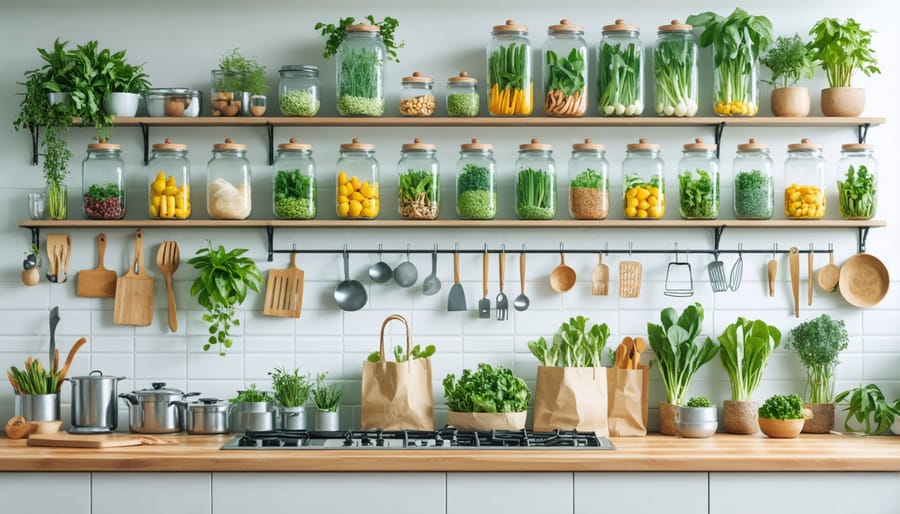
Energy-Aware Cooking Methods
Last weekend, while preparing dinner with my daughter, I had an “aha” moment watching her carefully stack multiple dishes in our steamer. It reminded me that energy-efficient cooking isn’t just good for our planet – it’s also a wonderful way to preserve nutrients and enhance flavors in our food.
Let’s start with the game-changing practice of batch cooking. By preparing multiple items simultaneously, you’re not just saving time but significantly reducing your energy consumption. Try organizing your oven space thoughtfully – roast your vegetables on one rack while baking a casserole on another.
When it comes to stovetop cooking, matching pot sizes to burners makes a remarkable difference. Using a small pan on a large burner wastes precious energy. Another tip I swear by is using lids whenever possible – this simple habit can reduce cooking time by up to 30% while keeping those valuable nutrients locked in.
The magic of residual heat is often overlooked. Turn off your electric stovetop or oven a few minutes before your food is done – the remaining heat will complete the cooking process. For dishes like rice or quinoa, I often turn off the heat halfway through and let them steam to perfection.
Consider investing in a quality pressure cooker – it’s my secret weapon for preparing tender beans and hearty stews in a fraction of the time, using significantly less energy. And don’t forget about cold preparation methods – overnight oats and marinated salads can be just as nutritious and delicious as their heated counterparts.
The Joy of Conscious Meal Planning
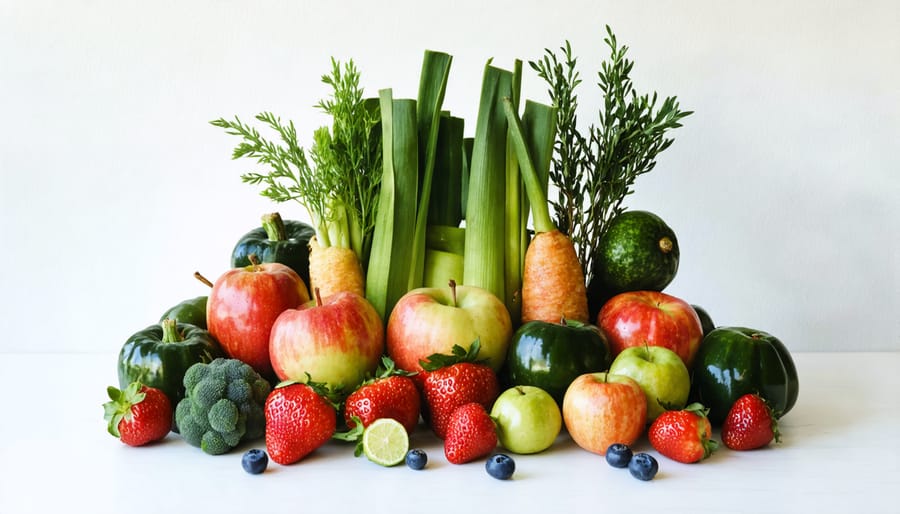
Seasonal Menu Creation
One of the most rewarding aspects of conscious cookery is embracing the natural rhythm of seasons in your meal planning. When you align your healthy meal preparation strategies with what’s naturally available, you’re not just creating more sustainable dishes – you’re also ensuring peak flavor and nutritional value.
I love starting each season by exploring local farmers’ markets and noting which produce is abundant. Spring brings tender asparagus and fresh herbs, summer offers a bounty of tomatoes and berries, fall welcomes hearty squashes and root vegetables, while winter celebrates sturdy greens and stored crops. This natural cycle provides a beautiful framework for menu planning.
Creating a seasonal menu doesn’t have to be complicated. Start by keeping a simple list of what’s currently in season in your area. Consider joining a CSA (Community Supported Agriculture) program, which naturally guides your cooking choices based on local availability. When planning your weekly meals, let the seasonal produce be your inspiration rather than starting with specific recipes in mind.
Remember, seasonal cooking isn’t about restriction – it’s about celebration. Each season brings its own unique flavors and cooking methods, from light summer salads to warming winter stews. This approach not only supports local farmers and reduces environmental impact but also connects us more deeply to our food and its origins.
Intentional Portion Planning
One of the most impactful ways to practice conscious cookery is through thoughtful portion planning. I learned this lesson the hard way after countless nights of preparing too much food, only to watch it slowly wilt in the fridge. Now, I approach serving sizes with intention, and it’s transformed both my cooking practice and my relationship with food waste.
Start by visualizing your meals before shopping. Consider how many people you’re feeding and their typical portion sizes. A helpful trick I’ve discovered is using smaller plates and bowls, which naturally guide us toward more reasonable portions while still feeling satisfying.
When cooking, try the “cook once, eat twice” method. Instead of making just enough for one meal, plan for intentional leftovers that can be repurposed. For example, tonight’s roasted vegetables can become tomorrow’s grain bowl topping or soup addition.
Keep a food diary for a week to track what actually gets eaten versus what ends up in the compost. This simple practice can be eye-opening and help you adjust your cooking quantities accordingly. Store leftovers in clear containers at eye level in your fridge – what’s visible gets eaten!
Remember, mindful portion planning isn’t about restriction; it’s about honoring our food by ensuring nothing goes to waste. When we cook with intention, we create a more sustainable kitchen and often find ourselves more satisfied with our meals.
Creating Your Conscious Kitchen Sanctuary
Creating a mindful cooking space begins with intention and awareness. Just as a yoga studio sets the tone for meditation, your kitchen can become a sanctuary that supports your conscious cooking journey. The way you transform your kitchen environment has a profound impact on your cooking experience and the energy you bring to your food preparation.
Start by decluttering your countertops, keeping only essential items within reach. I’ve found that having a designated prep station with my favorite cutting board, sharp knives, and a compost bowl creates a natural flow in my cooking process. Consider organizing your pantry with clear containers, making ingredients visible and accessible while reducing packaging waste.
Bring nature into your space with potted herbs by the window – they not only provide fresh flavors but also connect you to the growing cycle of your food. Natural light and good ventilation are crucial; they enhance your mood and keep the energy flowing freely.
Create mindful moments by setting up a small altar or gratitude corner. This could be as simple as a beautiful bowl of seasonal fruits or a vase of fresh flowers. I keep a collection of meaningful objects – a special spoon from my grandmother, a handmade ceramic bowl from a local artist – that remind me to stay present and grateful while cooking.
Consider the sensory experience: soft lighting for evening cooking, calming music or peaceful silence, and natural materials like wooden utensils and stone surfaces that ground you in the process. Keep a small journal nearby to note down recipe inspirations or mindful cooking observations.
Remember, your conscious kitchen should reflect your personal values and cooking style. It’s not about perfection but creating a space that supports your journey toward more mindful food preparation and consumption.
As we wrap up our journey into conscious cookery, it’s clear that this approach to food preparation offers so much more than just a way to prepare meals. Through mindful cooking practices, we create ripples of positive change that extend far beyond our kitchens. I’ve personally noticed how my relationship with food has deepened since embracing these principles, and many members of our community share similar experiences.
When we cook consciously, we naturally reduce food waste, make more environmentally friendly choices, and often save money in the process. It’s remarkable how being present and intentional while cooking can transform a daily chore into a fulfilling practice that nourishes both body and soul.
The benefits are profound: improved mental well-being through mindful practices, stronger connections with our food sources and community, and a lighter environmental footprint. Many readers tell me they sleep better, feel more energized, and experience a greater sense of purpose in their daily routines after adopting conscious cooking habits.
Remember, conscious cookery isn’t about perfection – it’s about progress. Start small, perhaps with one mindful meal preparation per week, and watch how naturally these practices begin to flow into other aspects of your life. As you continue on this path, you’ll discover that conscious cooking isn’t just about the food – it’s about creating a more intentional, sustainable, and joyful way of living.

